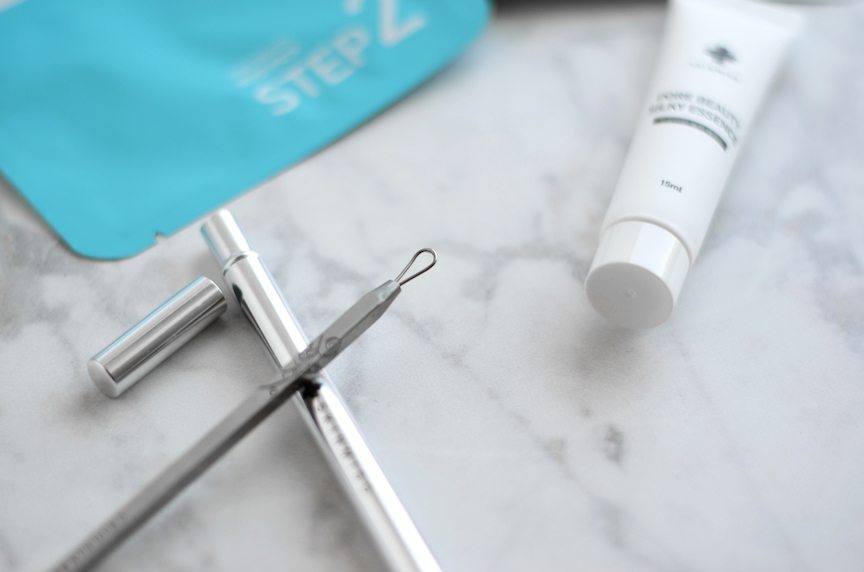They may have been the bane of your skincare life, but in order to get rid of them, you’ve got to get familiar with milia. Here, some easy ways to finally get smooth, bump-free skin.
_____________________________________________________________________
One night, upon finishing my bedtime skincare routine, I noticed that there were several mini bumps that had mysteriously formed along the left side of my cheek, plus a few nestled under my eye. It was obvious to me that these were neither pimples nor whiteheads, and my vain attempts to squeeze and pick at the bumps simply resulted in irritated skin (duh) and an even more irked me. These dome-shaped bumps were like nothing my skin had seen in my 20-some years — which covered an early onset of embarrassing acne (hello, awkward middle school years), oily T-zones, annoyingly dry patches, and ever-rosy cheeks — and they were like nothing I’ve ever felt before either: hard to the touch, completely painless, and utterly lost on me.
Cue the Google search. What I came across was a funny sounding name called milia, and apparently it’s a common skin dilemma that happens to people of all ages, ethnicities, and sexes. According to Healthline, these superficial bumps occur when keratin (a protein found in skin tissues, hair, and nails) gets trapped under the skin’s surface; a lone bump is actually called a milium cyst, and when formed in groups, they’re referred to as milia. You’ll often see these little bumps on newborn babies (aka baby acne), as well as on children and adults in various conditions, ranging from primary milia (entrapped keratin) to secondary milia (e.g., traumatic milia, which occurs when skin injuries like burns and rashes become irritated and clogged).
After the horrible mistake of clicking the image tab on said Google search, I was whipped into a frenzy, determined to find the solution to my milia woes before any more cysts decided to make themselves at home. To my pleasant surprise, it’s actually quite simple and easy to get rid of these little buggers. Here’s how you can, too.
At-Home Removal
Removing milia using at-home methods is a popular choice for its convenience and inexpensive cost. However, we mention this method with a caveat, as we don’t recommend using sharp objects on your skin — and especially near the eyes— if you don’t have past experience or the dexterity to successfully perform the “procedure.” With that said, all you will need is a couple of tools.

Start with a cleansed face. Paula Begoun behind Paula’s Choice Skincare recommends using a sharp needle, pointed tweezers, and/or a comedone extractor (like this one). Be sure to have alcohol swabs on hand to sanitize the needle or tweezer to prevent infection; then taking either tool, carefully make a tiny tear in the skin of the cyst. Taking the same tweezers or a comedone extractor, very (very, very) gently place pressure around the cyst to dislodge the tiny “pearl” of keratin from its place. And that’s it. Continue with the rest of your skincare routine.
Visit a Dermatologist
If the idea of taking a sharp needle and poking it into your face scares the life out of you, then we recommend visiting your local dermatologist. They’ll squeeze those suckers out from your face faster than you can say “milium cyst.” If you’re stomach can handle it, check out this informative video by Dr. Sandra Lee (also known as Dr. Pimple Popper), who uses a dose of anesthesia, a lancet (sharp pointed blade), and a Schaumberg-type comedone extractor to remove whiteheads and cysts from her patient’s face. (Warning: Skip the video if you're squeamish.)
Chemical Exfoliation and Retinoid Creams
Don’t care to break the skin barrier? Trust in your favorite skincare products to do the work for you. Chemical exfoliants and retinoid creams are known to effectively help rid of milia. According to WebMD, “retinoids work by prompting surface skin cells to turn over and die rapidly, making way for new cell growth underneath.” In the context of milia, this cycle of new skin cell growth will inevitably dislodge and remove the tiny bumps from their place; the prescription-required medication tretinoin seems to be a popular choice as far as retinol creams go. Chemical exfoliants like AHA (like this gentle option or these conveniently pre-soaked pads) work similarly. Plus, they help with PIH (those dark marks you get after a breakout). It’s a win-win.
If all else fails, most milia will go away on their own, assuming you’re taking the proper measures to cleanse and exfoliate to keep your pores clear of gunk. In my experience, I’m almost certain that my milia was caused by overuse of emollient, or moisturizing, products, as well as due to a lack of exfoliation. I was slathering on essences and serums like no tomorrow to make up for the cold and dry winter months; unfortunately, overuse of rich and heavy creams and products can cause the pores to become clogged. After realizing that my night creams and essences were over-hydrating my skin (I didn’t know that was a thing either), I switched out a few products and added in some new exfoliating facial scrubs to change up my routine. The result? Most of the smaller cysts are no longer noticeable, and the two most obvious ones have reduced in size and clarity. Maybe I’ll go in with my comedone extractor to finish off the job.
Have you experienced milia before? Let us know your story.
Loading...